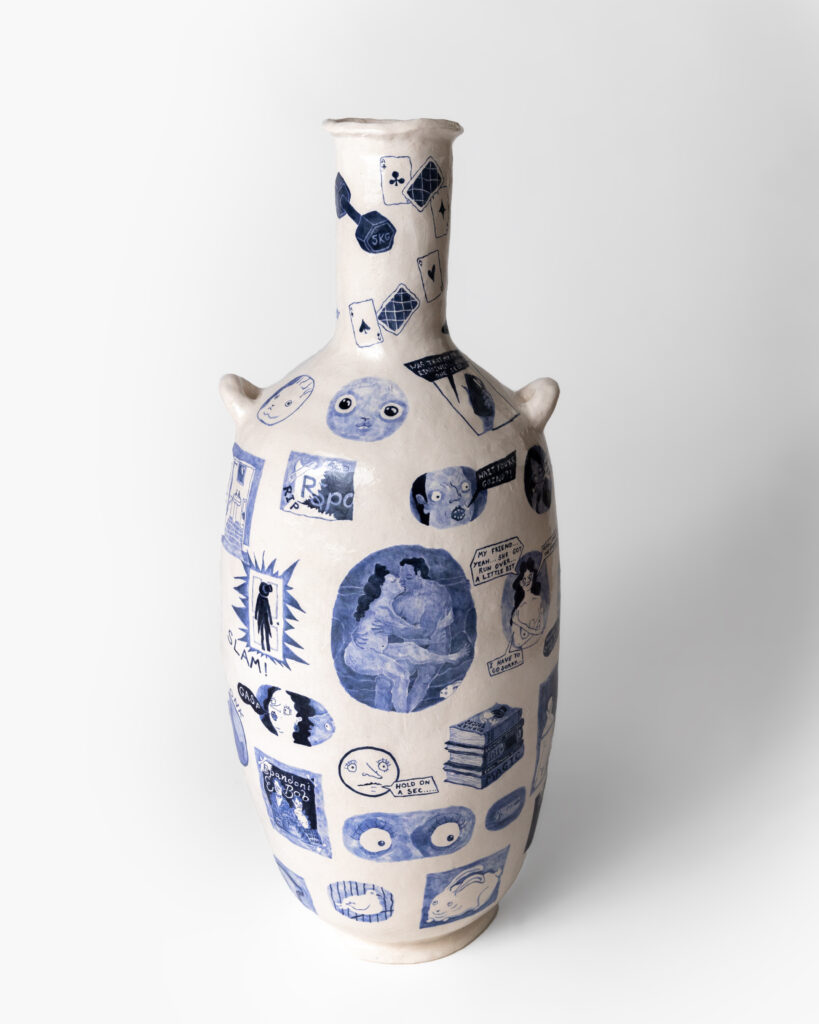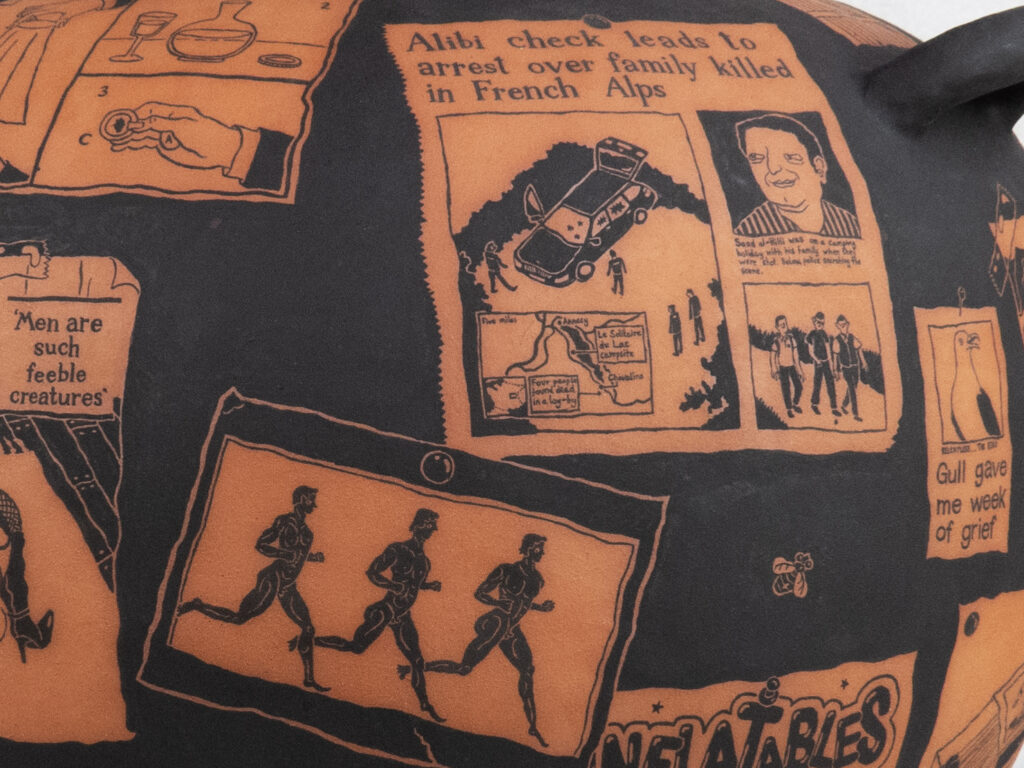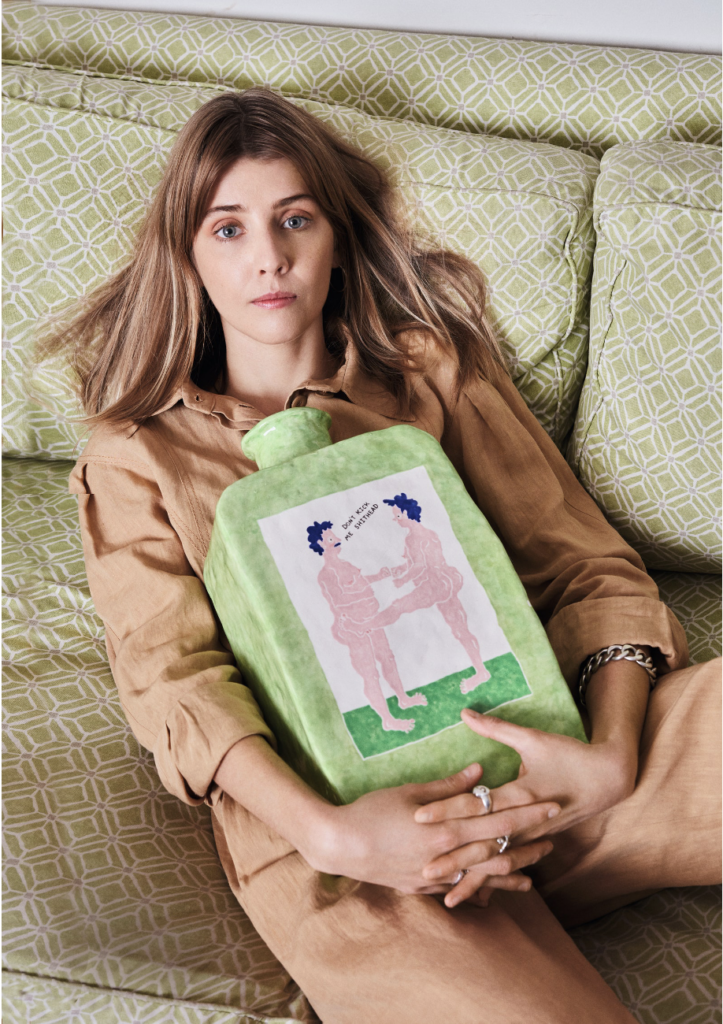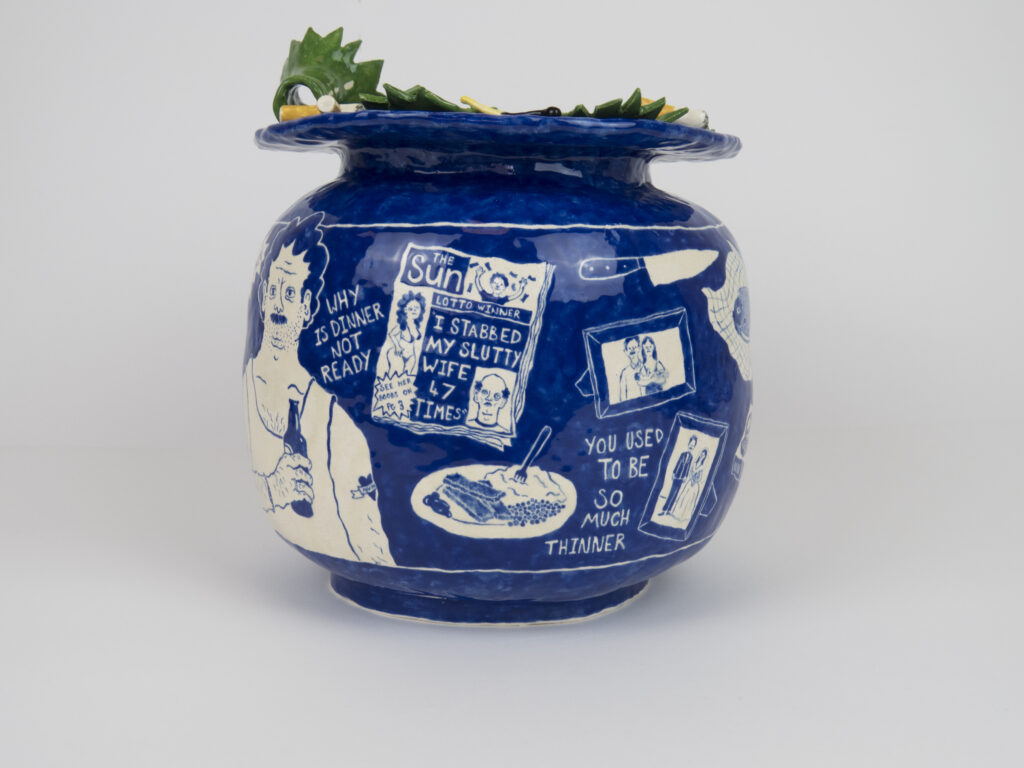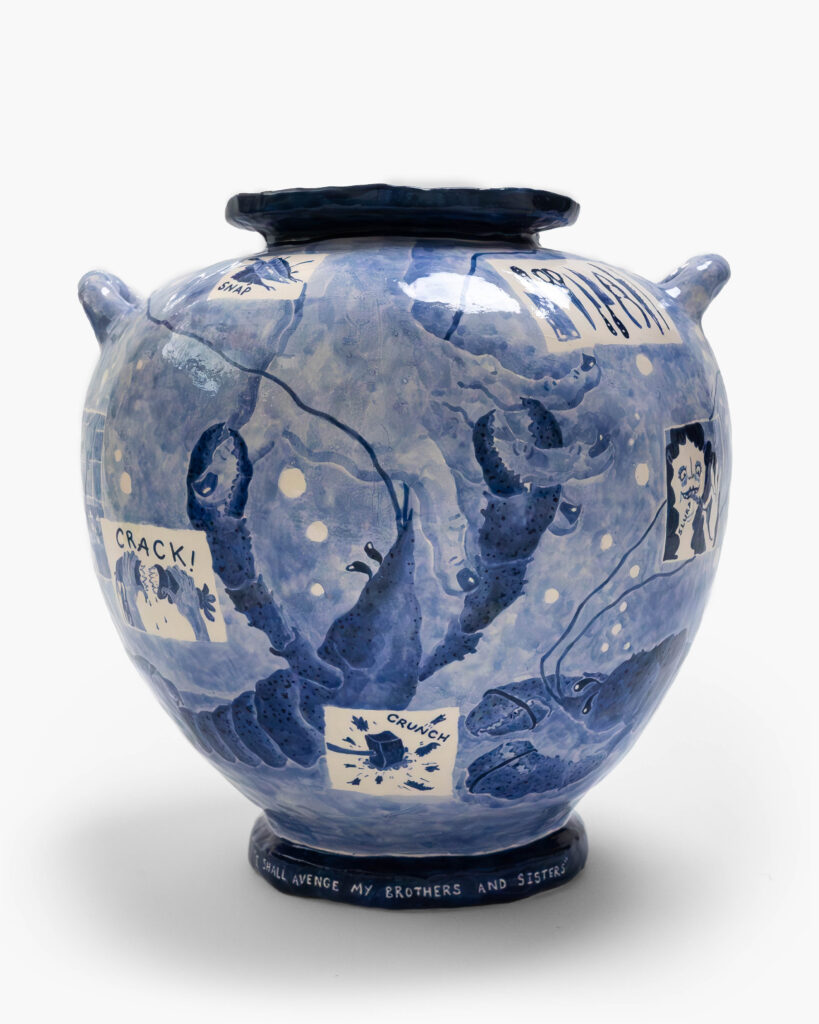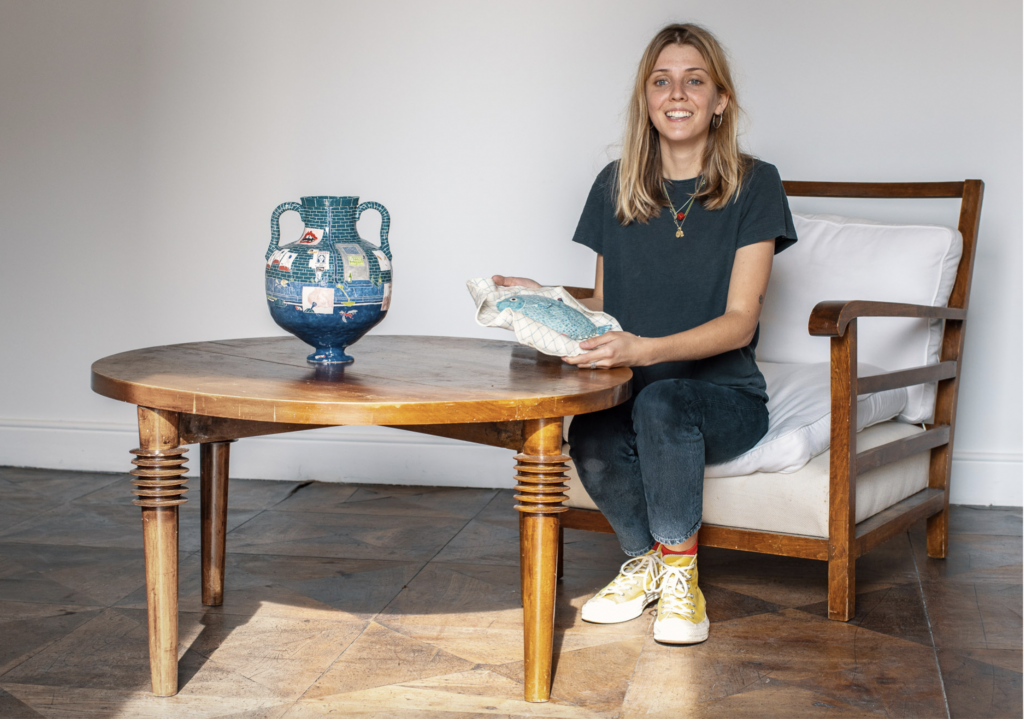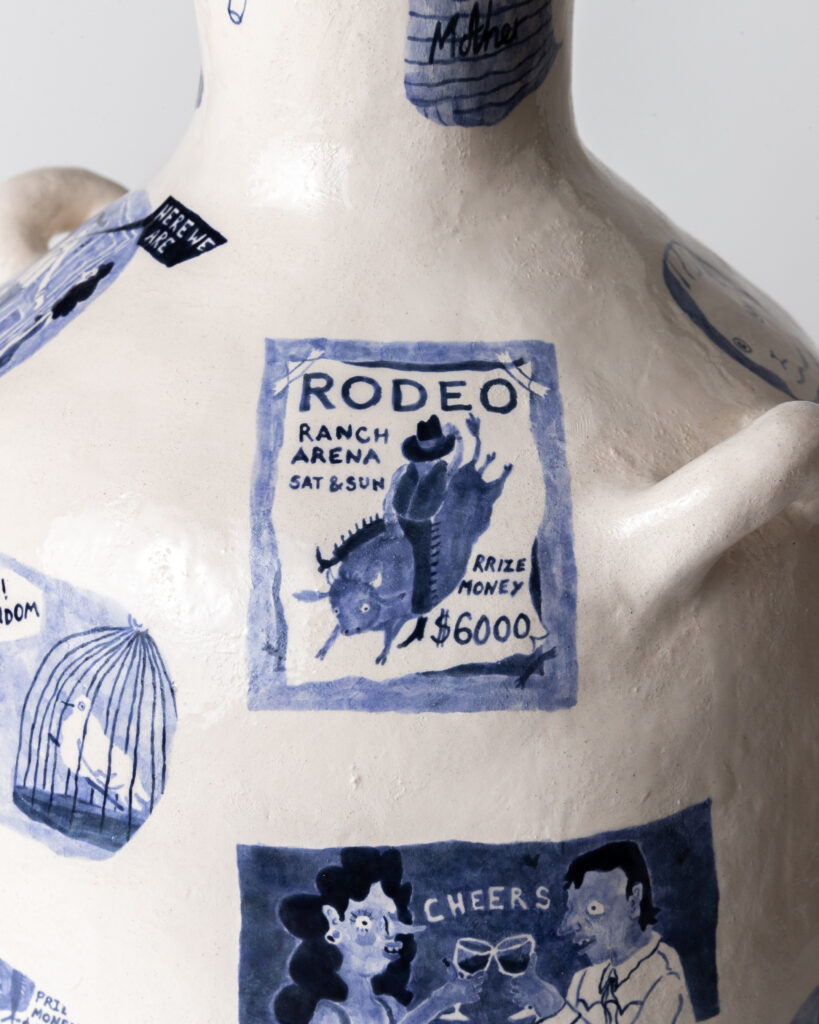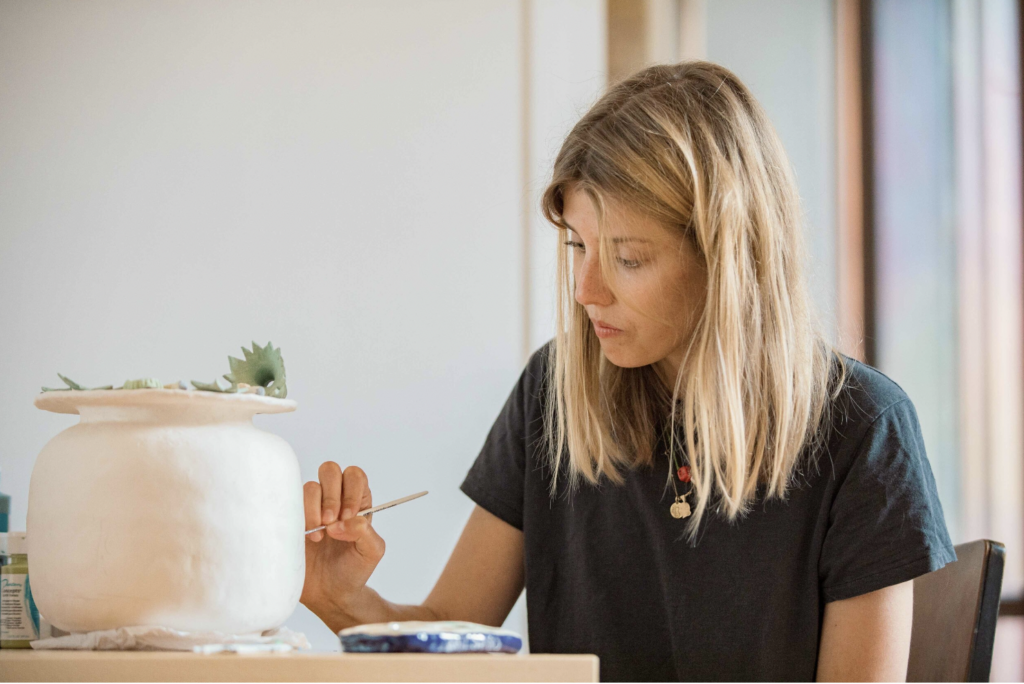
Ceramic artist Katy Stubbs was born in Hong Kong in 1992. Although her family are based in South Africa, she grew up and now lives and works in London.
Recently showcased at Timothy Taylor, New York alongside Tracy Enim, Louis Bourgois and Penny Slinger. Stubbs also exhibited at the Palazzo Monti, ‘Great Women Artists’ residency as well as the 2021 British Ceramics Biennial.
interview with ceramic artist KATY STUBBS
South African/British ceramic artist Katy Stubbs uses clay to tell stories. Her journey began at the School of Visual Arts in New York in 2015, where she first delved into the realm of narrative expression through classic, two-dimensional forms such as illustration and cartooning. However, it was the multi-faceted complexity inherent in ceramics—the myriad layers, angles, and dimensions—that ultimately beckoned Stubbs to explore the boundless avenues of storytelling within this dynamic medium. Less concerned with the expression of self, Stubbs rather communicates wider, more universal narratives she perceives of the human experience. With a long-standing appreciation for Classical Civilisations, Stubbs masterfully translates the timeless themes found in Greek mythology into the contemporary laments that have pervailed into our modern world: jealousy, hubris, gluttony – all will be punished in the end. Her tactful remoulding of the traditional amphora into vessels that echo their essence yet lack their function, humouressly toys at clay’s typically perceived marriage to utiltity, whilst immortalising the often morbid fables found intricately depicted on their surfaces. There exists a compelling parallel here between the artistic practices of Stubbs and one of South Africa’s foremost ceramic artists, Hylton Nel. Nel, an acknowledged muse for the budding ceramicist, became a pioneer of exposing darker social truths through the masquerade of humour and whimsical absurdity. His oeuvre is replete with national symbolism, featuring Proteas and Springboks, all entwined in a playful array of colours and inviting adaptations. As a result, these symbols become transformed as they are reimagined into a new national consciousness. In this way, Nel grapples with the unsettling political realities of late 20th-century South Africa, blending whimsy with profound commentary. Stubbs’ engagement with universal themes and her subversive approach to traditional forms echo Nel’s own artistic journey. Both artists employ humor and myth to challenge and reflect upon societal norms, creating works that are rich in narrative and symbolism. Stubbs’ reinterpretation of classical myths within modern contexts resonates with Nel’s reimagining of national symbols, illustrating how ceramics transcend mere craftsmanship to become a profound medium for storytelling and social critique. Stubbs therefore exposes narratives that bridge the temporal divide, creating works that eloquently speak to the human condition across ages. Her creations stand as testaments to the enduring power of clay, metamorphosing myth and symbol into vessels of deeper understanding and reflection.
How long have you been working with clay?
I started in 2015, so that’s about 8 or 9 years now.
How would you define clay and your relationship to it?
I would say I have a slightly tumultuous relationship with clay. Often when my work does not go as I had envisioned, I find myself blaming it, but after the anger has subsided, I can only really blame myself. For the most part, it is a relationship rooted in endless learning, and not trying to feel constricted by shape and form. Because ultimately, it’s just a case of planning your work and then you can pretty much make anything from there – clay is full of boundless potential in that way.
Which artists, either contemporary and historical, have had an impact on you over time?
I started my artistic career by studying illustration, finding great inspiration in the works of Edward Gorey, R. Crumb, The Hairy Who and Daniel Clowes, for example. Their work has had a huge influence on me and my love for storytelling.
Of course when it comes to ceramicists, there’s Hylton Nel, Grayson Perry and Genesis Belanger – all of whom greatly influenced my style of art-making. Following on from that, there are those unfired clay sculptures by Fischli and Weiss – I hope one day I can whip up something half as good and funny as those.
What other influences have seeped into your work during your career?
Magicians have been a big influence recently – I love all the paraphernalia. Now I am really interested in funerals and car crashes. Sounds morbid, but I find myself drawn to the deeper feelings of human emotion and experience – grief is certainly an underlying constant in that department.
Are there any traditional threads that exist in your practice? If so, what are they?
My first attempt at ceramics was really inspired by my teenage fascination with ancient Greek pottery. Recognising the extent of humanity’s shared experiences throughout time really struck a chord with me. I was really interested in the idea of ancient Greeks passing around these beautiful vessels, each with an assigned story and meaning even though they were designed for eating and drinking. The stories themselves were so fascinating, especially the intense violence they often portrayed.
Can you explain your process of making?
I always start with drawings. If it’s a pot, I will usually try to stick as close as I can to my sketch for the shape. The angle at the base from which the pot grows is always the hardest part. This is usually my reference point to see if the pot will turn out to be any good or not. I build most things using the handcoiling technique – I like the wobble of the slight imperfections and I find handoiling is the best way to retain the wobble. After firing, I will paint with underglaze.
What role does experimentation play in your artistic practice?
I have recently been trying out different ways of working and seeing how they can fuse into my practice. For example, recently I haven’t been experimenting directly with ceramics. Instead I have been drawing comics and painting a little, exploring my ability to engage in storytelling. I think they all feed into each other. I have recently been trying out different ways of working, seeing how they can fuse into my practice. For example, recently I haven’t been experimenting directly with ceramics. Instead I have been drawing comics and painting a little, exploring my ability to engage in storytelling. I think they all feed into each other. It’s also important to sometimes create art at a quicker pace and with less stress to keep the creativity flowing. Ceramics can be time-consuming, and unlike sketching and drawing, mistakes are much more noticeable when things go wrong.
What role does colour play in your work?
I like that bright colours can be used to hide dark themes – colour is a very powerful tool in that way. Using just one colour can be particularly provocative as it shifts the focus to line work and tone, engaging the viewer in a different way and emphasising the storytelling and ideas evoked in the work more.
Would you say your work is charged with emotion – If so, which emotions and do you think the viewer might be able to feel them?
I think maybe the emotion is in some ways a little on the callous side. I think my humour can be a bit cruel.
What are some of the core themes/concepts that you explore in your ceramic work, and why are they important to you?
I often find myself wanting to expose the deepest darkest sides of humanity. It seems these traits, such as gluttony, jealousy, hubris etc. have been plaguing us since the time of the Ancient Greeks. It’s like a morbid common thread that connects us through time – it’s quite depressing idea but nonetheless it’s interesting to consider and I enjoy confronting people with this reality in my work. I am also often trying to sneak my vegetarian agenda in but it might be a bit too well hidden…
What is your perception of the recent surge in interest in ceramic art?
It’s great – massive relief and hopefully it will last so I don’t have to get a proper job.
“My work is filled with a dark, skewed morality. Like the fate of the Ancient Greeks being handled by the Gods, I am the maker and I will determine the fate of the humans I depict.”
.
[Katy Stubbs in conversation with Art Formes]



